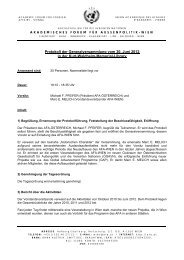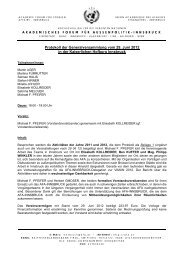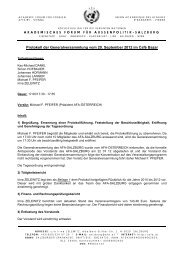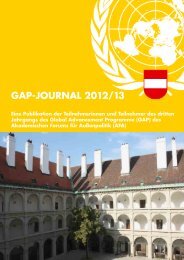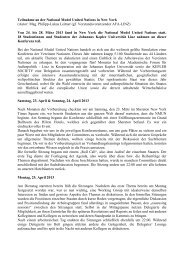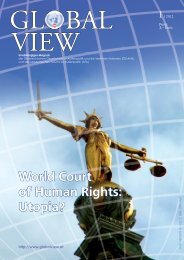Sie wollen auch ein ePaper? Erhöhen Sie die Reichweite Ihrer Titel.
YUMPU macht aus Druck-PDFs automatisch weboptimierte ePaper, die Google liebt.
8 International<br />
The "A-public" YouthMovement Going Public<br />
For years, sociologists have criticised young people for not getting involved in politics. The reason they found was a<br />
lack of interest in politics. Ever since theoutbreak of theGreen Revolution in Iran or the Arab Spring,itissafetosay:<br />
Young people arealiveand kicking. Text LaurettaKonradi<br />
The lack of involvement ofyoung people in<br />
traditional political structures has often been<br />
regarded as equal with adisinterest in politics.<br />
These classical structures included, for instance,<br />
party association, elections, and public discussions<br />
inorganized events. There, young people<br />
mainly caught attention through absence. As<br />
the events since 2009 show, this was due to the<br />
fact that they got involved in forms unseen publicly.<br />
Blogs and social media pages dedicated to<br />
acause or small local charitable initiatives have<br />
become more frequent in the last years among<br />
young people.<br />
Politics were not being discussed in physical forums,<br />
but in digital ones ranging from private<br />
groups and pages in social media to blogs and forums.The<br />
young were not a-political –theywere<br />
just "a-public".<br />
The protests in Iran after thepresidential elections of 2009 canberegarded as aforerunnerto<br />
other protestmovements in which socialmediaplayedacrucial role.<br />
Photo:WikimediaCommons /Hamed Saber<br />
The rise of social media<br />
Acouple of years ago, movements understanding<br />
the importance of and working through social<br />
media emerged quickly and unpredictably.<br />
When the Obama campaign was launched in<br />
2008, effectively involving bottom-up structures<br />
and promising change, young people were quick<br />
to join in. What was new about this was that he<br />
used Internet and social media like never before.<br />
Other politicians soon followed byopening up<br />
their own social media accounts, realising the<br />
power and reach these media have and understanding<br />
thattimeshad changed.<br />
But it was the year 2009 that first showed how<br />
much politics and social media/Internet had<br />
become intertwined for young people. When<br />
Mahmoud Ahmadinejad was declared the winner<br />
in the Iranian elections, an unprecedented<br />
campaign waslaunched (see picture). Nicknamed<br />
the "Twitter Revolution", social media were used<br />
by young Iranians to organizeprotests, sharepictures<br />
and videos, and to fight for their cause. An<br />
endless stream on Twitter provided live updates<br />
when traditional media had failed to keep pace.<br />
Young people were not only leading aphysical,<br />
but also an informationprotest.<br />
GLOBAL VIEW 3/2011<br />
An enhancing role in other protests<br />
The Arab Spring following one year later used<br />
the same methods –coordination and publication<br />
of protests via the Internet, notably via social<br />
media. This movement, too, had started out in<br />
real-life action (as, for example, the self-burning<br />
of ayoung man) and quickly found its wayonthe<br />
Internet, igniting even morenational andinternational<br />
action.<br />
In both these cases, it was young people protesting<br />
and even fighting atthe forefront for their<br />
rights. Similarly, in Austria, students organized<br />
protests againstracism among the Austrian population.<br />
This protest was solely organized by using<br />
Facebook, sending out invitations and encouraging<br />
everyone to followsuit.<br />
The reasons for these protests are manifold, but<br />
what catches attention isthat many well-educated<br />
young protesters were crucial to these movements.<br />
For years, young people have been told<br />
that ifthey wanted agood job, they would have<br />
to go to college and get aneducation. Now that<br />
they had that education, it was more difficult to<br />
find agood job, be it in the United States or in<br />
Europe. In Egypt, young academics more often<br />
end up in labourer jobs such as cab drivers. In a<br />
way, theyfelt trapped under that glass ceiling that<br />
theyhad believedcould be overcome. Before the<br />
protests, theyseemed to have losttrust and hope<br />
for their future and in the political systems that<br />
once aimed at guaranteeingtheir future.<br />
Conclusion<br />
As the world has changed in these past years, so<br />
too has the way young people are involved with<br />
politics: From atraditional waywhererules were<br />
pre-determined, they now changed to aself-determined<br />
way where they choose what and how.<br />
After lingeringfor atime in the private,the young<br />
generation has changed in the 2000’s toagain<br />
becoming more publicly engaged in politics. We<br />
have witnessed the youth movements’ potential<br />
and surely willsee it unfold in the yearstocome. I<br />
guess the following saying proved to be moreappropriate<br />
than ever before:Today’syouth arethe<br />
leaders of tomorrow.




